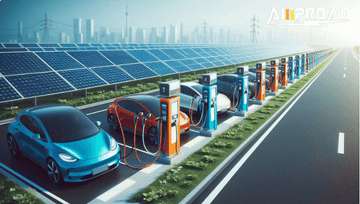
While electric vehicles (EVs) present a promising alternative to traditional gasoline-powered cars, the infrastructure supporting their adoption comes with its own set of challenges. Understanding these disadvantages is crucial for anyone considering the transition to electric mobility or investing in charging stations. Below, we explore the various downsides associated with EV charging stations.
1. High Initial Costs of EV Charging Stations
The Expense of Installation
Setting up an EV charging station can be a costly endeavor. Whether it's a public charging station or a home EV charger, the initial investment includes expenses for:
- Infrastructure Development: This encompasses the installation of electrical systems, power supply upgrades, and necessary cabling.
- Charging Equipment: High-quality charging station, particularly level 2 charger or level 3 evse, come with significant price tags, which can deter potential investors.
Moreover, if a site is chosen for a public charging station, the costs can escalate quickly due to the need for compliance with local regulations and potential site preparation.
Ongoing Maintenance Costs
After installation, maintaining the charging stations can add to the financial burden. Regular maintenance checks, potential repairs, and upgrades to keep up with technology advancements can all contribute to increased operational costs. This means that, while the initial investment is substantial, the long-term financial commitment is equally important to consider.
2. Long Charging Times for EVs
Charging Duration
One of the most significant drawbacks of EV charging stations is the time required to recharge electric vehicles.
- DC Fast Charging: While this method is faster than traditional charging, it can still take several hours to fully charge an EV, which is considerably longer than refueling a gasoline vehicle.
- AC Level 2 Charging: This slower charging method can extend wait times even further, often requiring overnight charging, making it less convenient for those on long journeys.
For drivers accustomed to quick refueling times, this transition can feel inconvenient and slow, potentially deterring them from making the switch to electric vehicles.
Implications for Long-Distance Travel
The longer charging times can lead to challenges during long-distance travel. EV owners may need to plan their routes carefully to ensure they have access to charging stations along the way, which can complicate spontaneous trips.
3. Range Anxiety: A Persistent Concern
Limited Driving Range
Despite advancements in battery technology, many electric vehicles still have a limited range compared to their gasoline counterparts. This limitation often leads to range anxiety—the fear of running out of battery power before reaching a EVCS.
- Electric Vehicle Limitations: Although the latest models can achieve impressive ranges, many drivers still worry about their vehicle's capability on longer journeys.
Charging Infrastructure Availability
The inconsistency and availability of public charging stations can exacerbate this anxiety. Drivers may find that:
- Rural Areas Lack Infrastructure: Many rural or less populated regions may not have adequate charging options, making long trips more stressful.
- Reliability Issues: Some public charging stations may be out of order or frequently occupied, leading to further frustration.
4. Inconsistent Charging Experience Across Networks
Compatibility Challenges
As the EV market grows, the variety of charging standards and connectors can lead to compatibility issues. Different manufacturers may use various charging protocols, creating obstacles for drivers who travel across regions or countries.
- Network Reliability: Users can encounter problems with charging networks, including outages or payment processing failures, which can interrupt the charging process and leave drivers stranded.
The Need for Standardization
For a seamless charging experience, the industry must move toward greater standardization of charging connectors and protocols. This is vital for ensuring that drivers can charge their vehicles without concern for compatibility issues.
5. Environmental Impact of Charging Stations
Electricity Generation Sources
While EVs themselves produce zero emissions at the tailpipe, the environmental benefits can be undermined by the sources of electricity used for charging.
- Fossil Fuels vs. Renewable Energy: If the electricity powering the EV charging stations is generated from fossil fuels, the overall carbon footprint may not be significantly reduced, thus limiting the environmental advantages of EV adoption.
Battery Disposal Concerns
Another significant environmental consideration is the disposal of EV batteries. Improper disposal can lead to harmful environmental effects, making it essential for manufacturers and users alike to prioritize sustainable practices.
6. Safety Risks Associated with EV Charging
Electrical Hazards
The high-voltage electricity used for EV charging comes with inherent risks. If safety protocols are not strictly adhered to, the likelihood of accidents can increase.
- Potential Electrical Shocks: Users must be cautious when handling charging equipment to avoid electrical hazards.
Fire Risks
Lithium-ion batteries, common in electric vehicles, are known for their energy density but can pose fire risks under certain conditions.
- Understanding Fire Risks: Awareness and proper handling of charging equipment are essential to mitigate these risks.
Addressing the Disadvantages of EV Charging Stations
As the demand for electric vehicles continues to rise, it is crucial to address the disadvantages associated with EV charging stations. By recognizing the challenges—such as high initial costs, long charging times, range anxiety, inconsistent charging experiences, environmental impacts, and safety risks—stakeholders can work toward solutions.
The Role of Professional Suppliers
To enhance the charging experience, investing in reliable infrastructure is essential. Professional suppliers like AMPROAD offer high-quality level 2 EV chargers, ensuring compatibility and efficiency. Additionally, products such as level 2 portable EVSE can provide flexibility for EV owners, enabling them to charge at home or on the go.
Overall speaking, while EV charging stations have their disadvantages, ongoing advancements in technology, infrastructure investment, and increased public awareness will likely alleviate many of these concerns over time. By fostering a robust charging network and promoting sustainable practices, the transition to electric mobility can be both efficient and environmentally friendly.


